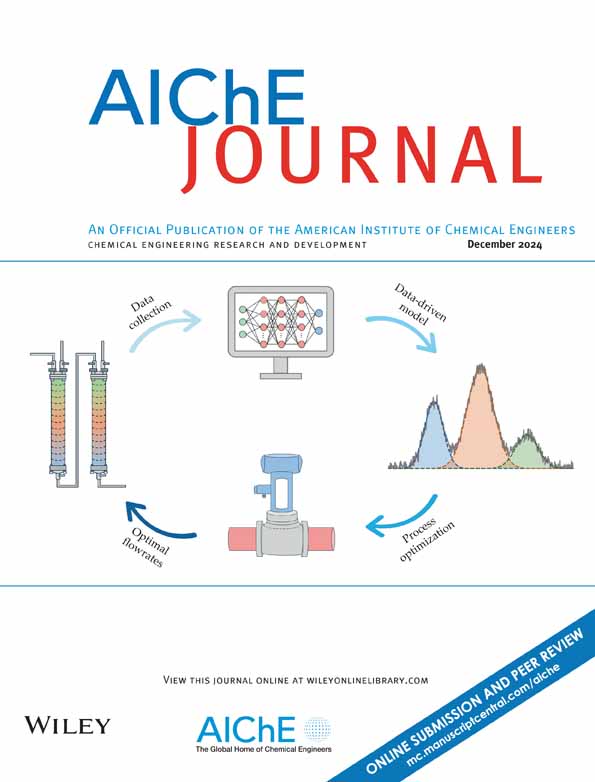Highly efficient propyne semihydrogenation over tin-modified Co-based intermetallic catalyst
IF 3.5
3区 工程技术
Q2 ENGINEERING, CHEMICAL
引用次数: 0
Abstract
Designing and fabricating uniformly dispersed non-precious metal active sites with tuned geometric configurations and local coordination environments for the selective conversion of functional groups to desired products is of great importance but remains challenging in industrial catalytic processes. In this work, we propose a straightforward method for synthesizing the Co3Sn2 intermetallic catalyst through the structural conversion of layered double hydroxide precursors, thereby constructing suitable Sn-modified Co active sites and an optimized catalytic environment for propyne semihydrogenation. Characterizations using x-ray diffraction, high-resolution transmission electron microscopy, and x-ray absorption spectroscopy characterizations are combined to identify the formation of P63/mmc Co3Sn2 intermetallic phase. Catalytic performance tests show that the Co3Sn2 catalyst achieves 95.0% propylene selectivity with nearly complete propyne conversion. Temperature-programmed surface reaction and desorption measurements combined with theoretical calculations demonstrate that the good selectivity is driven by the facile desorption of propylene from Sn-modified Co sites rather than its further hydrogenation.设计和制造具有可调几何构型和局部配位环境的均匀分散非贵金属活性位点,以便将官能团选择性地转化为所需产物,这一点非常重要,但在工业催化过程中仍具有挑战性。在这项工作中,我们提出了一种通过层状双氢氧化物前驱体的结构转换合成 Co3Sn2 金属间催化剂的简单方法,从而构建了合适的 Sn 改性 Co 活性位点和优化的催化环境,用于丙炔半加氢反应。利用 X 射线衍射、高分辨率透射电子显微镜和 X 射线吸收光谱进行的表征相结合,确定了 P63/mmc Co3Sn2 金属间相的形成。催化性能测试表明,Co3Sn2 催化剂的丙烯选择性达到 95.0%,丙炔转化几乎完全。温度编程表面反应和解吸测量结果与理论计算相结合证明,良好的选择性是由丙烯从锡改性 Co 位点的便捷解吸而不是其进一步氢化所驱动的。
本文章由计算机程序翻译,如有差异,请以英文原文为准。
求助全文
约1分钟内获得全文
求助全文
来源期刊

AIChE Journal
工程技术-工程:化工
CiteScore
7.10
自引率
10.80%
发文量
411
审稿时长
3.6 months
期刊介绍:
The AIChE Journal is the premier research monthly in chemical engineering and related fields. This peer-reviewed and broad-based journal reports on the most important and latest technological advances in core areas of chemical engineering as well as in other relevant engineering disciplines. To keep abreast with the progressive outlook of the profession, the Journal has been expanding the scope of its editorial contents to include such fast developing areas as biotechnology, electrochemical engineering, and environmental engineering.
The AIChE Journal is indeed the global communications vehicle for the world-renowned researchers to exchange top-notch research findings with one another. Subscribing to the AIChE Journal is like having immediate access to nine topical journals in the field.
Articles are categorized according to the following topical areas:
Biomolecular Engineering, Bioengineering, Biochemicals, Biofuels, and Food
Inorganic Materials: Synthesis and Processing
Particle Technology and Fluidization
Process Systems Engineering
Reaction Engineering, Kinetics and Catalysis
Separations: Materials, Devices and Processes
Soft Materials: Synthesis, Processing and Products
Thermodynamics and Molecular-Scale Phenomena
Transport Phenomena and Fluid Mechanics.
 求助内容:
求助内容: 应助结果提醒方式:
应助结果提醒方式:


